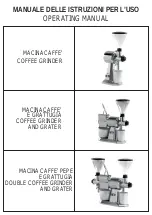
15
O R I G I N A L I N S T R U C T I O N S
GB
Do not use accessories that have not been designed by the manufacturer or intended for the work with the tool.
The fact
of ability to mount accessories on the tool does not ensure safe operation.
The maximum rotational speed of the accessories must be equal to or greater than the maximum rotational speed of the
tool.
Accessories with a lower rotational speed than the tool speed can disintegrate into fragments during operation.
The outer diameter and thickness of accessories must be within the size range speci
fi
ed for the tool.
It is not possible to
properly guard or operate improperly sized accessories.
The size of the hole used for
fi
xing wheels, discs,
fl
anges, and other accessories must match the size of the tool spindle.
Accessories with a
fi
xing hole size not suitable for the tool spindle size will start to vibrate during operation, which may result in
the loss of control of the tool.
Do not use damaged accessories. Before each use, examine the condition of the accessories for possible splinters,
cracks, abrasions and excessive wear. If any accessories are dropped, make sure they are not damaged, or mount new,
undamaged accessories. After checking and installing the accessories, make sure you and all bystanders stand outside
the rotation plane of the accessories, then run the tool for one minute at a maximum rotational speed.
Damaged acces-
sories will disintegrate during the test.
Wear personal protective equipment. Use face shields, goggles, or safety goggles, depending on the application. If re-
quired, use dust masks, hearing protection, safety gloves, and aprons to protect against small pieces of accessories or
materials generated during work.
The eye protection must be capable of stopping any
fl
ying debris generated during work. The
dust mask must be capable of
fi
ltering out dust generated during work. Exposure to noise for too long can result in hearing loss.
Ensure all bystanders keep a safe distance from the work area. Persons entering the work area must wear personal
protective equipment.
Debris or pieces of damaged accessories which are generated during work can be thrown out of the
immediate vicinity of the work area.
When carrying out work during which the disc may come into contact with a live, concealed electrical cable or power
cord, hold the grinder’s insulated handles only.
When the disc is in contact with a live wire, it may cause the metal parts of the
tool to become live, which may lead to electrocution to the tool operator.
Keep the power cord away from rotating tool parts.
If you lose control of the tool, the cord can be cut or caught, and your hand
or arm can be drawn into the rotating parts of the machine.
Never put down the tool until the rotating parts have come to a complete standstill.
The rotating parts can “catch” the ground
and pull the tool out of your control.
Do not turn on the tool while carrying it around.
Inadvertent contact with rotating parts can cause your clothes to be caught
and pulled in by the tool, which can result in contact with the operator’s body.
Clean the tool’s ventilation openings regularly.
The motor fan draws dust generated during operation inside the tool. Excessive
accumulation of metal particles contained in the dust increases the risk of electrocution.
Do not use the tool near
fl
ammable materials.
Sparks generated during operation may cause a
fi
re.
Do not use accessories that require liquid cooling.
Water or coolant may cause
electrocution.
The thread size of the accessories must match the thread of the grinder spindle. For
fl
ange-mounted accessories, the
fi
xing hole for the accessories must match the size of the
fi
fl
ange.
Accessories that do not
fi
t into the power tool mount
will cause imbalance, excessive vibration and may result in loss of control.
Warnings related to tool kickback towards the operator
The kickback of the tool towards the operator is a sudden reaction to a blocked or clamped: rotating disc, polishing belt, brush or
other accessory. Blocking or clamping causes a rotating accessory to stop suddenly, which results in the power tool rotating in the
opposite direction to the accessory rotation.
For example, if the grinding wheel is blocked or clamped by the workpiece, the edge of the disc that enters the clamping point may
sink into the surface of the material causing the disc to come out or be ejected.
The disc can also be ejected towards or away from the operator, depending on the direction of the grinding wheel movement at
the jamming point. Grinding wheels may also break in these conditions.
The tool kickback towards the operator is a result of misuse or failure to follow the guidelines in the instructions manual. This
phenomenon can be avoided by following the instructions below.
Use a
fi
rm grip on the tool and the correct position of the body and hands to withstand the forces generated by the
kickback. Always use an additional handle, if supplied with the tool, to ensure maximum control during the kickback or
any unexpected rotation during the tool start.
The operator will be able to control
the tool rotation or the kickback if appropriate
precautions are taken.
Keep your hands away from rotating tool parts.
The rotating parts can come into contact with your hands during kickback.
Do not stand in the area where the tool may move during the kickback.
The kickback will direct the tool in the opposite direc-
tion to the direction of the grinding wheel rotation, at the jamming point.
Pay special attention when working near corners, sharp edges, etc. Prevent the grinding wheel from runout and being
jammed.
When machining corners or edges, there is an increased risk of the grinding wheel
jam, leading to a loss of control or
tool kickback.
Do not use discs with a cutting chain for wood processing, segmented diamond discs with circumferential spacing be-
tween segments greater than 10 mm or discs with teeth. Such discs
cause frequent kickbacks and loss of control of the tool.
Содержание YT-82110
Страница 29: ...29 RUS residual current device RCD...
Страница 30: ...30 RUS...
Страница 31: ...31 RUS 10...
Страница 32: ...32 RUS...
Страница 33: ...33 RUS A A B C A B C A IV 3 2 3 2 III 80 M14...
Страница 34: ...34 RUS 10 0 I 30 V VI...
Страница 35: ...35 RUS 60 o C 80 0 3 MPa...
Страница 37: ...37 UA residual current device RCD...
Страница 38: ...38 UA...
Страница 39: ...39 UA 10...
Страница 40: ...40 UA...
Страница 41: ...41 UA A A B C A B C A IV 3 2 3 2 III 80 M14 10...
Страница 42: ...42 UA 0 I 30 V VI...
Страница 43: ...43 UA 60 o C 80 0 3 MPa...
Страница 115: ...115 GR RCD RCD...
Страница 116: ...116 GR...
Страница 117: ...117 GR 10 mm...
Страница 118: ...118 GR...
Страница 119: ...119 GR A IV 1 3 2 mm 3 2 mm III 80 m s M14 Velcro...
Страница 120: ...120 GR 80 m s M14 Velcro 10 mm 30 V VI 60O C...
Страница 121: ...121 GR 80 m s 0 3 MPa...
Страница 125: ...I N S T R U K C J A O R Y G I N A L N A 125...
Страница 126: ...I N S T R U K C J A O R Y G I N A L N A 126...
Страница 127: ...I N S T R U K C J A O R Y G I N A L N A 127...
















































